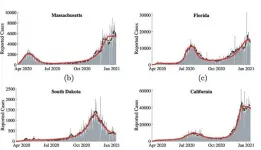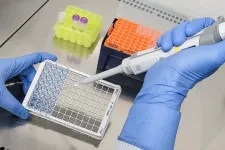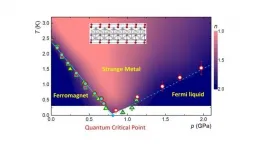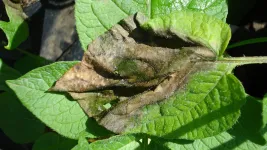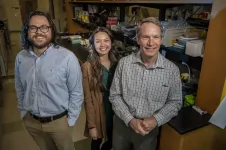(Press-News.org) PROVIDENCE, R.I. [Brown University] -- By adding behavioral components to an infectious disease model, Brown University researchers have developed a new modeling approach that captures the peaks and valleys in new COVID-19 cases seen over the past 16 months.
The approach, published in the journal Scientific Reports, could be useful in forecasting the future trends in the current pandemic, as well as in predicting the course of future ones.
"We know that people's behavior matters in terms of how an infection is spread," said Vikas Srivastava, an assistant professor of engineering at Brown and principal investigator of the research. "We wanted to see if we could quantify those behavioral aspects, incorporate them into a model and see whether that model is able to capture waves of infection rates we saw in the U.S. and elsewhere."
A commonly used approach to modeling infectious disease transmission is what's known as an SIR model. The approach separates a population into distinct categories: susceptible, infected and recovered. The model moves people from one category to another according to two parameters. The transmissibility of the disease, along with the rate at which people contact each other, predict how quickly people move from susceptible to infected. The rate of recovery moves people from infected to recovered. ("Recovered" in these models generally means "no longer contagious," which also includes those who have died from the infection.)
The standard SIR model produces a curve with a single peak -- the one that infectious disease experts urged people to flatten through social distancing, masks and other measures that reduce virus transmission. But over the last 16 months, actual case rates in individual states, in the U.S. as a whole and in other nations didn't produce a single curve. Instead, they produced multiple waves of infection that created a significant challenge for the infectious disease modeling community, Srivastava says.
As the pandemic unfolded, Srivastava was teaching a class that included a section on infectious disease modeling in Brown's School of Engineering. He and his students were surprised to see the mismatch between model predictions and actual case rates.
"We saw cases going up and down, creating multiple peaks, but models were falling short in capturing it," Srivastava said. "That's what got us thinking about using population behavior and response as a way to explain and predict what is happening."
Srivastava worked with two Brown undergraduate students, Zachary LaJoie and Thomas Usherwood, to develop the new modeling strategy. They modified a standard SIR model to include the effects of vaccination, and also added two behavioral parameters to the model. The first, "level of caution," estimates people's tendency toward safe behavior -- social distancing, mask-wearing and other safety measures -- as reported cases increase. The parameter also captures government actions in response to rising case rates, such as closures and quarantines, that increase safe behavior. A second parameter, "sense of safety," models people's confidence in a return to pre-pandemic activities as more people get vaccinated.
The team then used an optimization algorithm to calibrate values for the new parameters based on case rates reported in the U.S. With the parameters optimized, the team found that the model accurately reproduced case rates throughout the pandemic in the U.S. as a whole and in individual states and cities.
"When we looked at New York City, for example, we saw a spike in our level of caution variable right around the same time government action went into effect in late March," LaJoie said. "Then as cases went down later on, we saw the level of caution come down, and there was another surge in cases going into the holidays."
With the model properly fit to the data, it enables insights into how the pandemic may unfold in the future. For example, the team was able to measure how different rates of vaccine uptake might affect case rates. Rising rates of vaccination could drive a reduction in cases, but they could also reduce levels of caution and increase the sense of safety among the unvaccinated. That could put an upward pressure on case rates even as vaccines are pulling them down. In fact, the model predicts scenarios where brief periods of rising infection rates occur as vaccines are rolled out, before they eventually begin to decline again.
In the U.S., for example, the model captures a short period of increasing infection in mid-April before rates began falling again. Larger surges in places like India look similar to the more extreme post-vaccination surges the model predicts. At its current rates of vaccination, the model predicts that cases in the U.S. should approach zero by August 2021.
Insights like that, the researchers say, could be useful in places where vaccination programs are just getting underway.
"When we developed the model, we focused on the U.S., but it would definitely be useful for making predictions in other places like India, Europe or South America where case rates are still pretty high," LaJoie said.
The modeling approach could also be applied to future outbreaks or pandemics.
"There's really nothing in this model that limits it only to COVID-19 as a disease," Usherwood said. "We think this has applicability to any situation where people's behavior is important, which is basically any infectious disease."
INFORMATION:
Tsukuba, Japan - To study the immune system in human health and disease, scientists commonly use the genetic manipulation of mouse hematopoietic stem and progenitor cells (HSPCs) as a powerful model system. These studies have been extremely valuable in the fight against a number of human diseases. However, the current procedures are complex, time-consuming, and expensive.
In a new study published in NATURE COMMUNICATIONS, researchers at the University of Tsukuba have developed a novel technique that has the potential to overcome the limitations associated with these models, which are known as bone marrow (BM) chimeric mice. This system allows scientists to observe and investigate how ...
SARS-CoV-2 outbreaks involving care homes with fully vaccinated residents have been reported across Germany. In order to gain a better understanding of this phenomenon, a team of researchers from Charité - Universitätsmedizin Berlin used an outbreak at a Berlin-based facility to analyze virus-related data and study the immune responses of elderly residents following vaccination. The researchers' data, which have been published in Emerging Infectious Diseases*, confirm vaccine effectiveness in the elderly. However, they also indicate a delayed and slightly reduced immune response. In light of their findings, the researchers emphasize the need to vaccinate both caregivers and close contacts in order to better protect this high-risk group.
The BioNTech/Pfizer ...
Research combining systematic observations with cosmological simulations has found that, surprisingly, black holes can help certain galaxies form new stars. On scales of galaxies, the role of supermassive black holes for star formation had previously been seen as destructive - active black holes can strip galaxies of the gas that galaxies need to form new stars. The new results, published in the journal Nature, showcase situations where active black holes can, instead, "clear the way" for galaxies that orbit inside galaxy groups or clusters, keeping those galaxies from having their star formation disrupted as they fly through the surrounding intergalactic gas.
Active black holes are primarily thought to have a destructive influence on their surroundings. As they blast ...
At a classical second-order phase transition, condensed matter systems acquire long-range order upon cooling below the transition temperature, and the properties near the transition are driven by thermal fluctuations. These behaviors have been long explained by the Landau theory of phase transitions, which leads to the notion of universality, whereby systems with very different microscopic constituents exhibit certain universal macroscopic behaviors close to a phase transition. Some condensed matter systems however can be tuned so that the phase transition is suppressed to zero temperature at a quantum critical point (QCP), where the behaviors are no longer driven by thermal fluctuations, but by quantum fluctuations arising as a consequence of Heisenberg's uncertainty principle.
Heavy ...
North Carolina State University researchers continue to track the evolution of different strains of the plant pathogen that caused the Irish potato famine in the 1840s, which set down roots in the United States before attacking Europe.
NC State plant pathologists studied the genomes of about 140 pathogen samples - historic and modern - from 37 countries on six continents to track the evolution of differing strains of Phytophthora infestans, a major cause of late-blight disease on potato and tomato plants.
The study, published in Scientific Reports, shows that the historic lineage called FAM-1 was found in ...
Human papillomavirus (HPV) vaccines applied in national vaccination programs protect against most cancers associated with oncogenic, high-risk (hr) HPV types. Two recent studies demonstrate the impact of gender-neutral HPV vaccination in the overall protection against hrHPV infections already with low vaccination coverage.
More than 30 000 12-15-year-old Finnish girls and boys participated in a community-randomized trial that evaluated the impact of gender-neutral vs. girls-only HPV16/18 vaccination in the two school years of 2007-2008 and 2008-2009 in 33 communities. To evaluate the occurrence of HPV infections, pre- and post-vaccination serum samples collected in the same communities were used to measure the antibodies against ...
A new high-performance plastic foam developed from whey proteins can withstand extreme heat better than many common thermoplastics made from petroleum. A research team in Sweden reports that the material, which may be used for example in catalysts for cars, fuel filters or packaging foam, actually improves its mechanical performance after days of exposure to high temperatures.
Reporting in Advanced Sustainable Systems, researchers from KTH Royal Institute of Technology in Stockholm say the research opens the door to using protein-based foam materials in potentially tough environments, such as filtration, ...
WESTMINSTER, Colorado - June 06, 2021 - Many invasive plants are expanding their growing range in response to climate change, making early detection and rapid response more critical than ever. Limited resources, though, can make it impossible to track and manage every range-shifting species.
To help invasive species managers bring focus their efforts, a team from the University of Massachusetts suggests prioritizing potential invaders based on the threat they represent.
In a research project featured in the journal Invasive Plant Science and Management, the team explored data on 87 plant species that are projected ...
A plant-based diet appears to afford significant protection to rats bred to become hypertensive on a high-salt diet, scientists report. When the rats become pregnant, the whole grain diet also protects the mothers and their offspring from deadly preeclampsia.
Although we have all heard to avoid the salt shaker, an estimated 30-50% of us have a significant increase in blood pressure in response to high-salt intake, percentages that are even higher and more impactful in Blacks.
The two new studies provide more evidence that the gut microbiota, which contains trillions of microorganisms that help us digest food and plays a key role ...
In cultures that place a high value on conventional gender norms, particularly those that prize men as the breadwinners in a family, their unemployment plays an outsized role in whether a romantic relationship ultimately succeeds or fails.
That's according to new research from sociologists Pilar Gonalons-Pons of the University of Pennsylvania and Markus Gangl of Goethe University Frankfurt. They published their findings in the journal END ...
